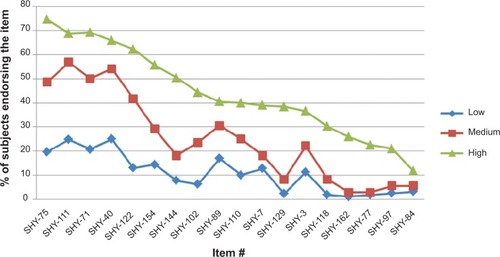Figures & data
Table 1 SHY-SR domains score: comparisons among low, medium, and high scorers
Table 2 SHY-SR domains scores: sex comparisons in low, medium, and high scorers
Table 3 Most common social situations and performances feared in the total sample and in the three severity groups
Figure 1 Percentage of endorsement of the SHY-SR items related to avoidant behavior, arranged by decreasing frequency among high scorers (>68) as compared with medium (59–67) and low (0–58) scorers.
Abbreviation: SHY-SR, self-report questionnaire of the Structured Clinical Interview for the Assessment of Social Anxiety Spectrum.

Table 4 Odds ratios and 95% confidence interval of endorsing seven physical symptoms in social situations for subjects who reported experiencing physical symptoms during childhood/adolescence
